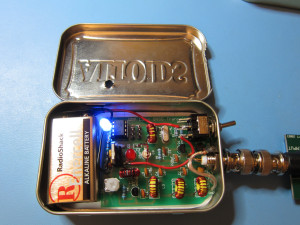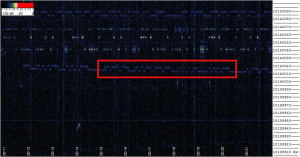Crossing the pond with 100 milliwatts
QRSS is a term used in ham radio to mean “very slow speed morse code”. QRPp means “using a very low power radio transmitter”. What happens when you combine these concepts? Small, simple, radios that can communicate over thousands of miles using about the same amount of power as a TV remote control.
The radio shown above is based on a kit by Hans Summers, G0UPL, that I picked up at the Four Days in May QRP convention. It uses a single-sided circuit board, with three transistors, one crystal, five toroids, a basic microcontroller, and a handful of resistors and capacitors. I added a 5v regulator, an LED to show the keying activity, and put it in an Altoids tin. The whole thing probably cost about $25 in parts, and took one evening to assemble.
After building it and tweaking it to get it on exactly the right frequency, I hooked it up to the dipole on the roof of NYC Resistor, and flipped on the power switch. My 100 milliwatt signal went up into the sky, bounced around between the ionosphere and the ocean a bit, and was picked up by a radio operated by Johan, ON5EX, in Belgium. He runs what is known as a “grabber” — a radio and computer combination that monitors the QRSS portion of the 30m band, converts the signals into digital spectrographic images, and publishes them on the internet.
Here is a screen capture from Johan’s website shortly after I powered on my transmitter. It shows about 100Hz of spectrum (frequency is on the vertical axis) over 11 minutes (horizontal axis). My signal is in the center of the graph. It’s my call sign, W2VV, sent repeatedly in morse code (·–– ··––– ···– ···–) at about 10.140015 MHz. If you listened to this signal as audio, you would mostly hear static. The horizontal lines you see in the graph would come out as tones. The higher the line, the higher the pitch of the tone. My signal would sound like a tone that changes pitch ever so slightly up and down as the dots and dashes are sent. However my signal would probably be so weak as to be inaudible through the static. It is only discernible when converted to visual form and then compressed over a long period of time.
Belgium is about 3600 miles away from New York, which means this transmission achieved an amazing power efficiency of 36,000 miles per watt. Also, it occupied just a tiny sliver of bandwidth — only 5Hz, meaning many other people could share the same range of frequencies without interfering with each other. However you don’t get something for nothing in life, and the tradeoff in this situation is that very little information was sent. It took six minutes just to send my four-character callsign. Still, that’s not a bad deal for a $25 radio that fits in your pocket.
Visit my Flickr page for more photos of the build. Better yet, come to our Ham Party on Saturday and see it for yourself! And if you can’t make it to our place, visit one of the hundreds of other ham radio clubs across the country hosting public events this weekend in honor of ARRL Field Day.
72/73, Dave W2VV


Hi Dave,
Fine work and congratulations on the success! I'm glad you're enjoying the kit! Note though; you have the URL for the kit a bit incorrect and it points to one of my older QRSS projects (definitely NOT an easy one). The actual URL should be http://www.hanssummers.com/qrsskit .
72/3 Hans G0UPL
Good catch. Thanks. I updated the link.
Perhaps the ultimate in QRP is the Voyager deep space probe that transmits on S-Band (8 GHz) at 23-watts and communicates at 160 bits/sec over 11 billion km (with 10 hour latency). The uplink is an astounding 16 bits/sec.
You mentioned a club. I had to go back to Boston (to my old club WARA64.org) for field day. Does NYCResistor have a QRP club? I would be very interested in that.
73,
Jon
w1jp
Unfortunately we don't have a QRP club, but you might want to check out the NJQRP club at http://www.njqrp.org/ . I believe they meet once per month in Princeton. I've never been, but I'd like to go someday.
Very cool! Keep up the good work…KC2SIZ
Is that an Altoids case? Pretty cool
My signal that sounds like a voice that changes the pitch ever so slightly up and down as dots and dashes are sent. However, my signal would probably be low enough to be inaudible due to static electricity.
Pond Filters
Really neat.. I enjoyed that- Andrew
I have seen some pretty cool security cameras disguised as random everyday items.
Obsolete Components
Is it required to have a Ham operator’s license? I suppose it would matter what part of the spectrum you’re using for that to REALLY be an “issue,” other than the fact that Big Bro seems to have assumed ownership of everything these days. 🙂
There’s a nice open source QRSS beacon here: http://www.etherkit.com/transmitters/openbeacon.html
30m, various mode (HELL!), and can also do WSPR. its source code is available on Github, along with the board layout and pretty much everything involved.